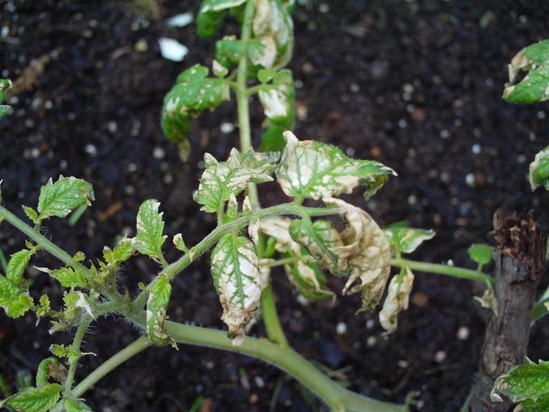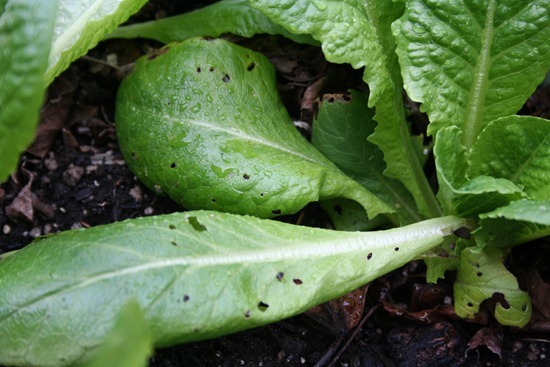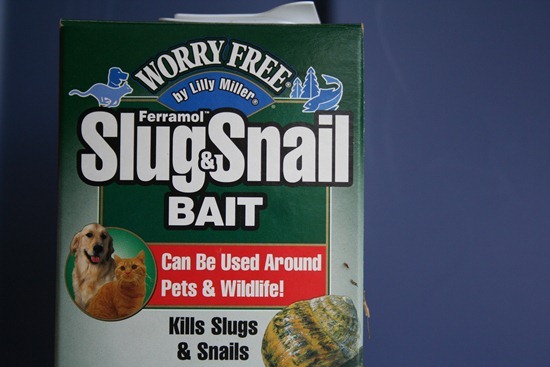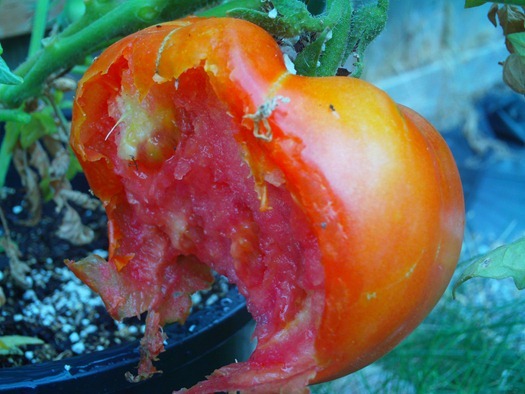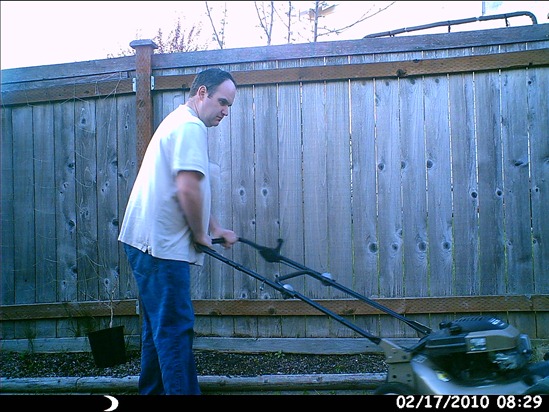All About the Tomato Hornworm: From How to ID Them to Best Tomato Hornworm
12.7 years ago organic, pests, tomato
Tomato hornworms are common garden pests. This post will show you how to identify them and the best tomato hornworm control methods.
About the Tomato Hornworm
The tomato hornworm becomes the five-spotted hawk moth. In its caterpillar form, it is incredibly disastrous to gardens and landscapes.
How to ID the Tomato Hornworm
The tomato hornworm is 4-5 inches long, once full size. Typically they are the largest caterpillars you will see in your garden. Green in color it has white V-shaped marks. Their color and markings help camouflage them in your garden. In fact, you may see their destruction before you see the actual caterpillar.
Tomato hornworms have enormous appetites, destroying entire leaves, stems and immature fruits.
Given their name, many incorrectly assume they only attack tomatoes. However, they also attack eggplants, peppers and potatoes. In a matter of days they can completely defoliate a plant.
If you don’t recognize their damage or spot one, you can ID these vicious pests by their black droppings, called frass, found at the base of plants or on leaves.
How to Control Tomato Hornworms
One of the simplest ways to control tomato hornworms is to pick them off whenever you see them. They are large and easy to grab when you spot them. Either squish them or spray them with organic pesticides.
Handpicking, however, can be time-consuming. Only best for very small gardens, handpicking will ultimately leave behind some of the caterpillars. And because even just one caterpillar will cause extensive damage, handpicking is often not the most effective way to end their infestation.
Beneficial Insects
There are insects that eat the tomato hornworm, such as the praying mantis. However, beneficial insects may not be in your garden. If you add these beneficial insects, they will end up leaving for other food sources once they can’t find pests in your garden anymore. Thus, relying on them as your sole form of pest control gives the pests another chance of infestation.
Applying BT
BT, or Bacillus Thuringiensis, can be used to treat a tomato hornworm infestation. However, it only works on small larvae, leaving the plant-destroying adults behind to continue their extensive damage.
Best Organic Tomato Hornworm Control
They make really effective organic pesticide products. They are easy to use and kill the tomato hornworms at all stages, ensuring you a healthy organic garden.
Available as sprays and powders, the most effective ones:
· Kill 45 different insect species
· Exterminate them at all stages, from eggs to adults
· Are ready-to-use
· Are OMRI Listed, which means they’ve been reviewed and approved for use in organic gardening.
Guest Author Byline This guest blog post is written by Michelle Anderson who specializes in insect control, including organic pesticides and insect killer.
Removing pests from your garden using animal traps
12.9 years ago guest post, pests
Unfortunately, at one time or another, most homeowners will encounter the need to defend their turf from some four-legged nuisance. Animals wreak havoc in yards and gardens, feasting on vegetables, seedlings, flowers, bulbs and trees. Some animals even burrow and create tunnels, effectively destroying the roots of plants. One of the best ways to get rid of an unwanted animal is a live animal trap. In this article, learn how to use live animal traps, including how to choose the right trap, bait it, and find its most effective location.
Animal Traps
Live animal traps are designed to capture the animal alive and are typically composed of an open mesh, rust-resistant steel frame. The mesh opening will vary in size depending on the animal being trapped. Smaller cages have smaller mesh doors for trapping smaller animals while larger cages have larger mesh doors for trapping larger animals. The most effective traps will have smaller openings to prevent the animal from escaping with stolen bait.
Food bait is used to lure the animal into the cage. Upon entering the cage, the animal activates a trigger, causing the door(s) to shut. There are a variety of different traps. Single entry traps are only open at one end and are designed for safe, secure catch-and-release while 2-door models allow the animal to enter from either direction. There are also collapsible models that are easy to transport and take less space to store when not in use.
Animal Trapping: How To Get Started
First, determine what animal is causing the damage in your yard. This will help you choose what size animal trap you need, in addition to the proper bait. The following is a general guide for each trap size: consult the manufacturer for the precise size needed according to the trap’s specific dimensions. An x-small trap is ideal for mice, chipmunks, voles and rats. A small animal trap will catch squirrels and rabbits. To trap opossums and skunks, use a medium trap. Large traps are used for capturing raccoons, armadillos, muskrats, groundhogs, cats and larger opossums. An x-large animal trap works for raccoons, groundhogs, opossums, armadillos and dogs.
Choosing The Right Bait For The Animal Trap
Choosing the right bait for the animal you are targeting is essential to a successful trapping experience. Here are a few bait suggestions for the most popular unwanted creatures.
- Squirrel Bait: cereal, nuts, grains, sunflower seeds, apples, peanut butter, popcorn
- Rabbit Bait: carrots, brussel sprouts, lettuce, apples
- Raccoon Bait: fish, watermelon, honey-covered vegetables, corn, fatty meat, marshmallows
- Cat Bait: fish, meats, sardines, tuna, chicken
- Armadillo Bait: worms, maggots, sardines
- Skunk Bait: chicken entrails, canned fish, beetles, bacon, cat food
- Vole Bait: peanut butter and molasses on whole wheat bread
- Chipmunk Bait: sunflower seeds, peanut butter, prune pits, cereal, popcorn
- Mice Bait: cheese, nuts, peanut butter, gum drops
- Groundhog Bait: string beans, lettuce, peas, cantaloupe, strawberries
Choosing The Ideal Animal Trap
When choosing your trap, there are a few things to keep in mind. Select an animal trap that is easy to set and release. The best traps allow you to set and release with one hand, making it less complicated to use. If the animal is being released, these types of animal traps provide the user with more safety and protection. With a full hand guard and a galvanized steel barrier separating the user from the animal, an easy set trap allows the user to stand behind the trap while single-handedly releasing the animal back into the wild.
Look for a trap that is sturdy and rust-resistant, as these traps will last through many years of trapping in all types of weather and climate conditions, offering better value for your investment. Spring-loaded doors with sensitive triggers are another important feature when choosing an animal trap. These traps ensure a quick, secure capture, preventing undesirable catches. Finally, keep in mind animal traps with smooth internal edges can protect trapped animals from injuries.
Capturing Animals with Animal Traps
Test all new traps prior to use to ensure they are working and you have set them properly according to the directions. An easy set animal trap is practically infallible and the ideal solution to virtually any animal problem. First decide the placement of the trap, which is crucial to performance. Place the trap away from human traffic and pets. Locate places where animals congregate or travel along paths and place animal traps along these routes in dark, shaded areas. Since animals often stay close to water, traps placed near water sources are also more successful.
After the spot has been selected, camouflage the trap with leaves, branches and dirt to give it a conditioned look. Choose the proper bait, spreading the bait around the trap and leading into the trap. Then activate the trap. A brand new trap may need a few nights to be effective, so be patient. If trapping is unsuccessful, move the trap location and/or change the bait.
Remember to check traps often. Trapped animals should not be left exposed to heat and cold. In addition, wild animals can become increasingly stressed out when left in traps too long, potentially injuring themselves.
When an animal is caught, place a towel over the trap to calm and shield the animal during transport. Contact your local state game commission to determine the lawful method of releasing a captured wild animal. If releasing the animal with an easy set animal trap, simply stand behind the trap and single-handedly release the animal. After every use, the animal trap needs to be washed and disinfected with a bleach solution and thoroughly rinsed with water.
Guest Post By: Havahart®
What’s wrong with this tomato plant?
13 years ago disease, pests, tomato
I have my best guess on this one, but can’t seem to find any pictures online that match this tomato problem. So to confirm what do you think the problem could be?
Slugs eating my lettuce
13 years ago lettuce, pests, slugs
Previously I did an entire post on deterring slugs from your garden, but I was so excited to get these romaine lettuce plants out of my grow box and into the garden I put off the slug prevention a little too long.
As you can see these guys are pretty little but they still can do some serious amount of damage in a short period of time. There are many methods to prevent slugs in your garden, but I went with methods based on materials I had on hand.
First I started with some Slug and Snail bait, this is more environmentally friendly kind which will not kill off the cats, dogs, birds in your neighborhood but when the slugs get a taste it will eliminate their appetite and/or encourage them to forage for food elsewhere.
After picking of the chewed on leaves which removed the slugs chewing on them from the garden, promotes a healthier plant, and gives the hides the evidence that this attack never happened. I also removed some of the leaf mulch around the plants to give the slugs a less optimal hiding place. I topped all of this up by sprinkling a 1/4 cup of egg shells around the plants which irritates the slugs delicate undersides to hopefully encourage them to look for lunch elsewhere.
Catching garden pests in the darkness with OutbackCam night camera
13 years ago infrared, night cam, pests, product review
In the past I have had a few critters scale or crawl under my fence to snack on my tomatoes. Without knowing what is going after my crops it is difficult to figure out how to attempt to prevent these attacks. When Swann approached me to review their OutbackCam I decided this would be the perfect tool to answer this question.
The OutbackCam is a small device that holds a digital camera which with the help of motion sensor and an array of infrared LED lights can take quality pictures/videos of anything that moves within its range during the day or night.
Installation of the devices is very simple, you use the provided strap to attach the device to a fence post, tree, etc. and pull snuggly to keep it in place. This is fine for catching animals in the act, but if humans are your target you may want to provide your own cable and lock or protected enclosure to prevent someone with a pocket knife walking away with your camera and evidence it may have captured.
The camera provided numerous settings to allow you to choose between taking photos and videos and also the amount of time you want to delay between photos to prevent using up the whole card while lets say you are mowing the lawn. This configuration I would not call intuitive (meaning I actually had to look at the instructions) but I would consider no more difficult than setting a new digital watch. Once you understand the settings and the flow it is very easy.
Though it is a few months before I will be able to catch any animals going after my tomatoes I did turn it on and captured some less threatening creatures to confirm the image quality and the number of false positives.
Overall the device was very accurate there were very few false triggers and after I was unable to catch any critters in my garden I decided to simulate a zebra attacking a seedling in my kitchen which was pitch black when the picture was taken.
One things I did notice when taking the picture above the camera does make a mechanical noise when it takes the picture. Which could scare away the trespasser (which in my case could be a good thing) but if you are looking to catch many pictures of Bigfoot in your back woods this may not be the camera for you.
The camera uses an SD memory card (same used for many digital cameras) which you can plug into the media slot of your computer to view as needed.
Overall I think this is a great gadget for capturing wildlife (wanted or unwanted) and is easy to setup is pretty effective at capturing photos based on movement in its range. It is rugged we have had some pretty intense weather here over the past few months (hard rain, hail, snow) and the enclosure has stayed completely dry. As for using for “human pests” I would recommend using this due to the internal storage of photos and the ease it is for the “pests” to walk off with your photos and your camera. Though if you are able to install this in a location that is not easily reachable or visible it could work as a standard security camera.
Disclosure: I was given a free sample to review this product but not compensated or affiliated with Swann Communications Inc for this review.
How to keep deer out of your garden
13.1 years ago deer, guest post, pests
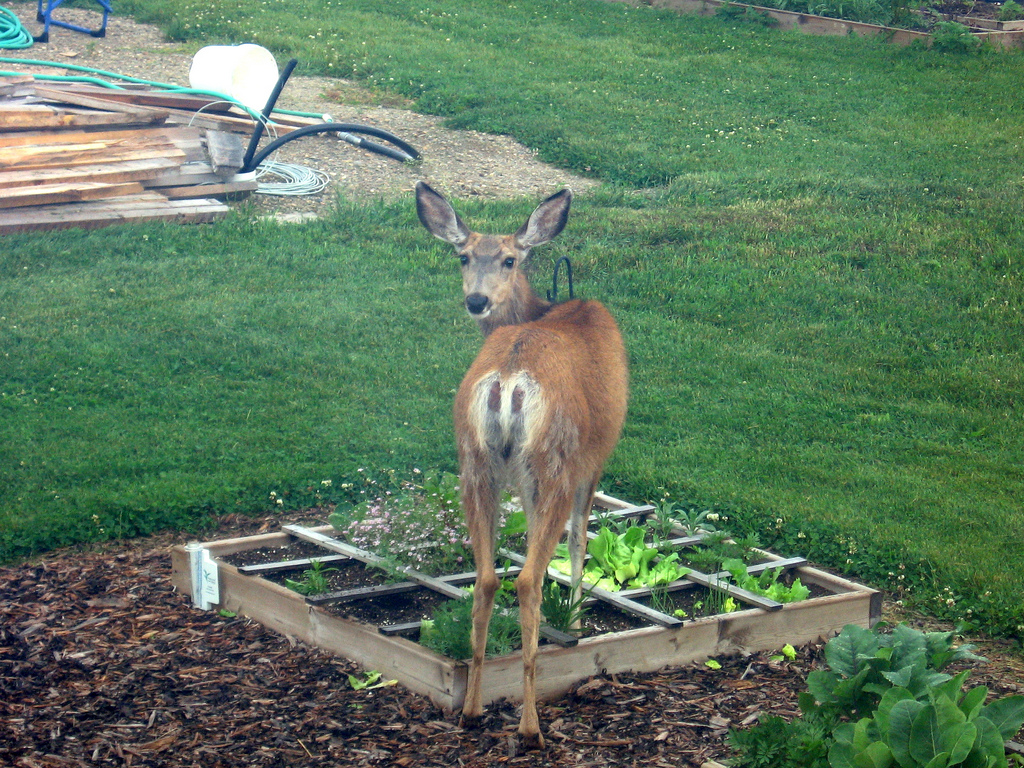
Photo from Alberta Home Gardening
Ever-Increasing Deer Damage
Deer are one of the most widely distributed mammals, inhabiting every continent throughout the world, except Antarctica and Australia. As the human population increases, the natural habitats of deer continue to decline causing deer to have no where to go, but developments and suburban areas. The result is a continual increase in property damage caused by deer. Not only is property damage an issue, deer harbor diseases that can be passed to humans, pets and livestock. Finding an effective deer repellent is crucial to protecting your family, pets and yard.
There are many ways to control deer from entering your land and destroying your property. Some are effective and others are not. One method that is not very effective is planting “deer proof” plants. The label “deer proof” is in fact a misnomer because a hungry deer will eat any plant when preferred food sources are scarce.
Another option is installing a fence around your property. This method is also not the best deer repellent as deer can jump over fences, even as high as 8 feet. Installing a fence is not only ineffective, it is also costly and detracts from the look of your landscape.
There are more effective and cost-efficient methods to stop deer from entering an area. They include motion detector sprinklers, liquid deer repellents and electronic deer repellents. These methods harmlessly condition deer and other wildlife to stay away. (Preventing Deer Damage)
A Motion Detector Sprinkler – An Innovative Deer Repellent
An effective, cost-efficient, and safe deer repellent is the innovative motion detector sprinkler. This type of deer repellent utilizes water spray and noise to create a humane and highly effective solution to property damage caused by deer. Not only is it effective on deer, it can protect areas from all types of destructive animals, including cats, dogs, raccoons, groundhogs, opossums, skunks, squirrels and geese. The motion detector sprinkler keeps cats from using gardens as their litter box, prevents dogs from digging up recently seeded lawns, and keeps rabbits from feasting on gardens. Moreover, it is the perfect way to prevent cats, raccoons and birds from eating fish out of a decorative pond. A safe, effective alternative to chemical repellents, the motion detector sprinkler is also a highly economical solution in place of fences, perfect in those areas where fencing is not an option due to aesthetics or local land ordinances.
How The Motion Detector Sprinkler Works
This humane animal and deer repellent offers 24-hour protection for yards, gardens and landscaping. When the infrared motion sensor detects movement, a startling burst of water ejects from the sprinkler. The “tic tic tic” noise of the sprinkler, combined with the sudden jet of water, causes a negative experience for the trespassing animals and wildlife. This negative experience conditions them to avoid the area in the future. Motion detector sprinklers will guard up to 35 feet in every direction for a total of 1000 square feet of coverage. To protect a greater area, link multiple sprinklers together. Thanks to the random spray pattern and adjustable sensitivity detector these innovative sprinklers use, animals won’t become accustomed to the water sprayer.
Setting Up A Motion Detector Sprinkler
A motion detector sprinkler installs quickly and easily. First, determine proper placement to increase its effectiveness. Place the system where you see animal or deer paths. Look for tracks or droppings and intercept the animals on their way to food, such as vegetable plants, flowers, shrubs or ponds. The simple set up consists of installing a standard battery, connecting the sprinkler to a hose, and using the step in stake to push the unit into the ground. High-tech systems include an infrared proximity and pivoting sensor, which automatically turns the unit on when deer are in sensing range. Eco-friendly models use only 2-3 cups of water per spray. Mid-range models offer remote functionality, timer options and a sprinkler mode. Premium models can be placed in any location since they are solar-powered and hose-less, as water is supplied by a refillable basin (Havahart Spray Away).
Liquid Deer Repellent
The most effective liquid deer repellents target both the highly developed sense of smell and taste of deer. Putrescent egg and garlic target the deer’s sense of smell. To a deer, these scents mimic the smell of a decaying animal, fooling the deer into thinking a predator is nearby. This activates the deer’s flight response, causing the deer to flee the area out of fear. Capsaicin, the active component of chili peppers, targets the deer’s sense of taste. A deer will immediately stop feeding on plants treated with capsaicin due to the burning sensation upon contact, making capsaicin an excellent deer deterrent. Liquid deer repellents are applied directly to plants and come in convenient, ready-to-use formulas. Higher end liquid deer repellents are undetectable to humans after drying and only need to be reapplied every few months. If using in vegetable gardens, be sure the liquid deer repellent has the OMRI logo, which means it is approved for use in organic gardening (Capsaicin).
Electronic Deer Repellents
Electronic deer repellents work very similar to an electric fence. They are battery-powered and installation is easy. Simply apply a scent lure to the deer repellent posts and stake them along paths that deer frequent. The deer that wander on a homeowner’s property won’t be able to resist temptation of the scented lure and will touch the posts and receive a static shock. This gentle, yet unpleasant, shock will condition the deer to stay clear of your yard, providing effortless 24-hour protection (Havahart Electronic Deer Repellent).
Works Cited
Preventing Deer Damage. 12 May 2010
Capsaicin. 19 April 2010. 22 April 2010
Havahart Spray Away. 12 January 2011
Havahart Electronic Deer Repellent. 12 January 2011
Guest Post Written By Havahart®


